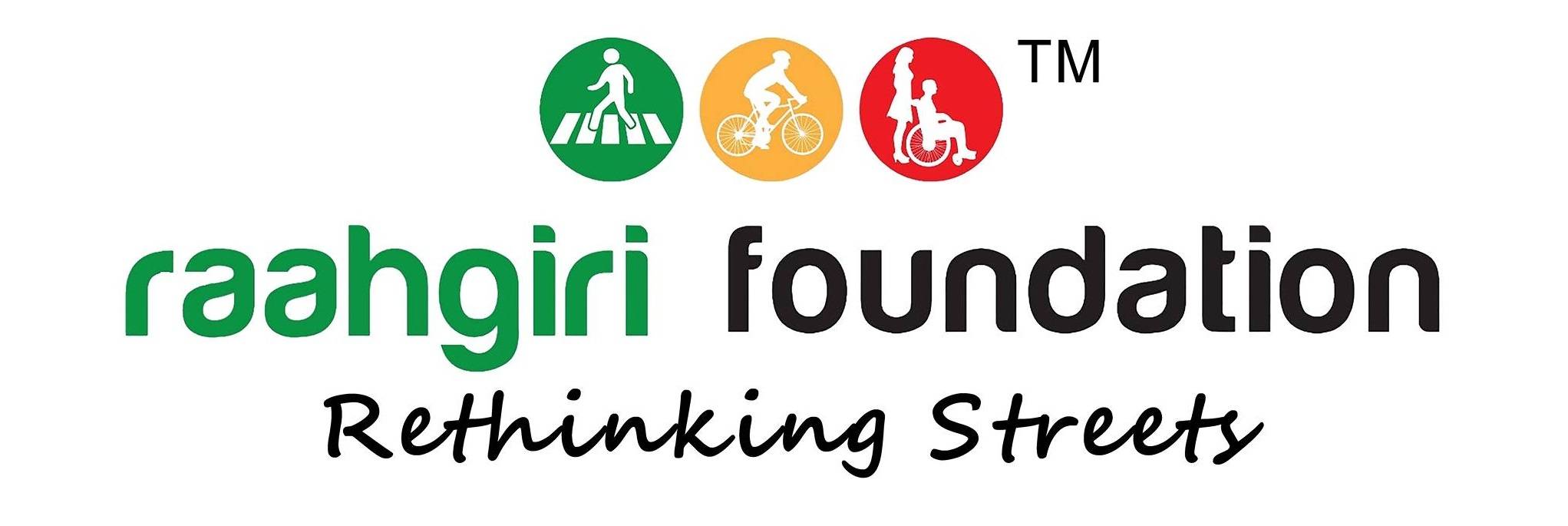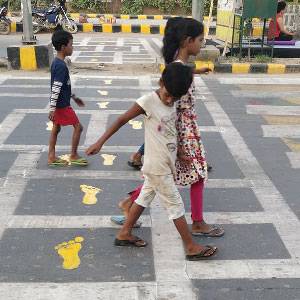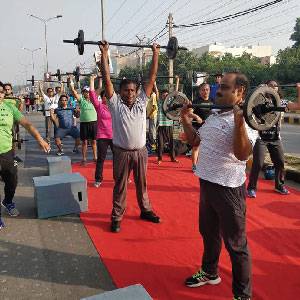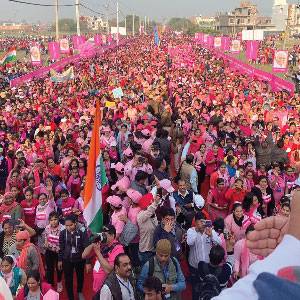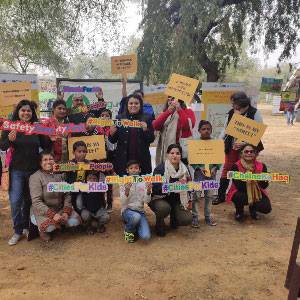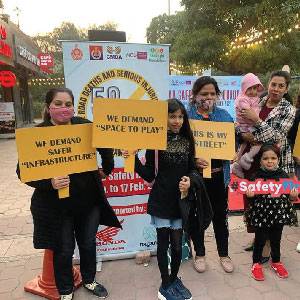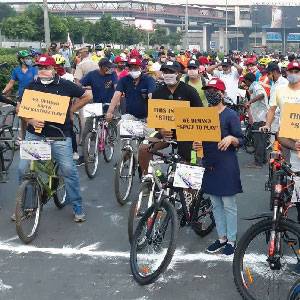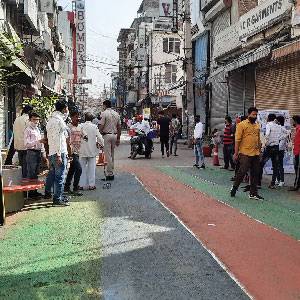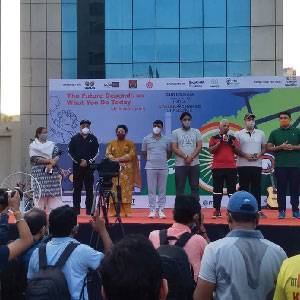How Raahgiri is creating carbon-neutral streets
What does carbon neutral mean?
Put simply, having carbon-neutrality implies that any C02 released into the environment by company or human activity is to be balanced by an equivalent amount being removed. In the context of climate change, carbon (CO2) refers to the greenhouse gases released by the combustion of fossil fuels, land use change and other human activity (Carbon Free Boston, 2021)
Today, half the world’s population lives in cities and that number is estimated to increase to 70% over the next 20 years. Sub-optimal urban and transport planning has only added to the increase in carbon emissions leading to high levels of air pollution and noise, heat island effects, and lack of green and open spaces for physical activity which has led to an increase in morbidity and even premature mortality.
Recent estimates show that that 60–80% of final energy use globally is drained by urban areas and more than 70% of global greenhouse gas emissions are produced within urban areas. To be able to survive sustainably in the future, major changes in urban and transport planning are required.
How does Raahgiri contribute to creating carbon-neutral streets?
One of Raahgiri’s core objectives is to advocate for sustainable mobility systems, which in turn curbs physical inactivity, reduces air pollution and promotes safer and more sustainable street design and use. This is done both through several of our projects, as well as through behavioural and mindset shifts – one example of which is the Raahgiri Day.
Raahgiri Day in itself will not be able to curb our high emissions of carbon, but it enables a mindset shift on how we view our streets. It’s a public temporal urban event that makes a statement by enabling people to reclaim a stretch of city-road, banning the entry of motorized vehicles. This activates people experientially and initiates use of public spaces for fitness and recreational activities. Thereby, facilitating a naturally safer environment.

(Raahgiri Foundation introducing junction correction and new crossings for pedestrians and cyclists at Sector 44, Gurugram, to encourage active and sustainable modes of mobility)
In short, Raahgiri advocates for low-carbon mobility, which essentially implies disincentivising motorised vehicle use, along with promoting non-motorised and good public transport, and the introduction of alternative fuels infrastructure (UNECE, 2011)
Reducing carbon footprint in cities is no longer only important, but essential.
Raahgiri Foundation has conducted several projects with an aim to move closer to streets that are carbon neutral, a few of which are discussed below.
Our Projects
- Pedestrianization of Sadar Bazar Market
The vision of this project was to create safer, inclusive and sustainable street design through the pedestrianization of the historic 600m section of Sadar Bazar (the main market street), supported by comprehensive circulation and a traffic management plan.

(School girls enjoying the car-free space before their school playing hopscotch- the trial gave them a chance to reclaim and celebrate their street)
A trial was conducted by the Municipal Corporation of Gurugram (MCG) in collaboration with all other stakeholders through the use of tactical urbanism. A comprehensive design was created and executed with low-cost, repurposed pieces that gave several forms of effective and bright seating with an emphasis on engaging with the community throughout trial-week. Other components added to the main street include walkability by pedestrianization, cyclability via tactical bike parking, vegetation via tire planters, trash segregation and disposal with MCG dustbins, and spaces to interact via the installation of cubes.
Among a few other objectives, one of the primary goals for this pedestrianization was to reduce congestion, and subsequently reduce carbon emissions.
- Redevelopment of Neighbourhood Street – South City 1
The objective here, similar to that of the pedestrianization, was to provide a safe, vibrant and sustainable neighbourhood street which is slower, safer and that encourages last mile connectivity through active mobility.
After a thorough study and a road safety audit, 4 km of street space was to be transformed. The report was submitted to the authorities, and going forward, comprehensive designs and estimates would be created for the area focusing on the area’s walkability aspects and implementable plan to create footpaths in the existing cross-sections.
The planning and design of walkable environments in residential communities is essential to encourage sustainability through active modes of transport and also due to the numerous benefits it provides in terms of public health, sustainability, the economy, and social life. The built environment has an impact on walking not just in the good sense of promoting it, but also in the bad sense of preventing it. He project will be a model street for neighborhoods, exhibiting ways in which existing areas can become more walkable with minimal interventions.
Once again, the fundamental objective is to make streets safer and more sustainable for urban residents in terms of general street safety, but also the long-term objective of providing cleaner air, lower levels of congestion and a major reduction in emissions.
- Anath Road – a collector model street in an Industrial Area
The vision for this project was to create cohesive streetscapes that act as a prototype for pilot for all Gurugram streets – inclusive, sustainable and safe, located as a collector road in an industrial sector.
A 30M wide road was converted into an inclusive public space for all road users. A street cross-section with a 10M carriageway and the rest of the area was distributed in equity to accommodate all other road users such as pedestrians, cyclists, vendors, utilities etc. The focus was to provide accessible, inclusive, and safe pedestrian and cycling infrastructure that promotes active mobility and public transport and bring in a modal shift.
The street would be the first of its kind in the city, prioritizing vulnerable road users over motorized movement. It aims to impact the approach of street design in the city, which needs to be more comprehensive. All the trees are preserved in the new cross-section design, setting an example of the concept that respects the context.
This is another important aspect of emissions to consider. As long as we as a citizenry continue to cut down trees and reduce green spaces, achieving carbon neutrality is virtually impossible. Groves of trees have the ability to act as carbon sinks, and can help sequester twice as much C02 as they emit (Punjabi, 2021). Raahgiri recognises that alongside better street design, a comprehensive plan of action to maintain and improve our green spaces is essential.
Way forward
Public spaces in most cities are, to a large extent, dedicated to motorized vehicles, and our Indian cities are no exception. This has led to high levels of air pollution, increased noise and stress levels, increased physical inactivity, and a lack of green and open space.
It has been found in research that designing pedestrian-friendly and cycle-friendly movement networks, and enhancing the desirability of active travel modes (for example, creating safe, attractive neighbourhoods and safe, affordable, and convenient public transport) to encourage walking, cycling, and public transport use, while reducing private motor vehicle use – creates healthier and more sustainable, compact cities that reduce the environmental, social, and behavioural risk factors that affect lifestyle choices, levels of traffic and environmental pollution.
Better urban and transport planning, as is being advocated and pursued by Raahgiri Foundation, can lead to carbon-neutral and more liveable spaces for our citizenry, particularly through land use changes, a move from private motorised transportation to public and active transportation and greening of cities.
ALL CONTACTS
- C-157, Anand Vihar, Vikas Marg Extension, Delhi, India, 11009
- Office +91-8826865797
- raahgirifoundation@gmail.com
- Copyright All Rights Reserved : Raahgiri Foundation
- raahgirifoundation@gmail.com
